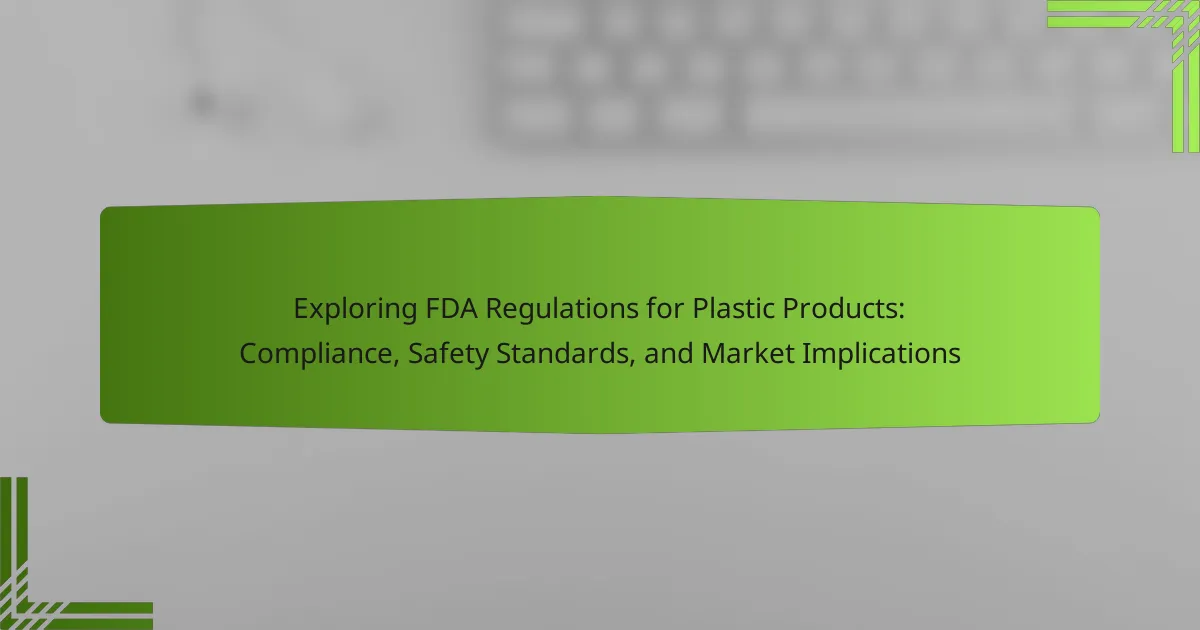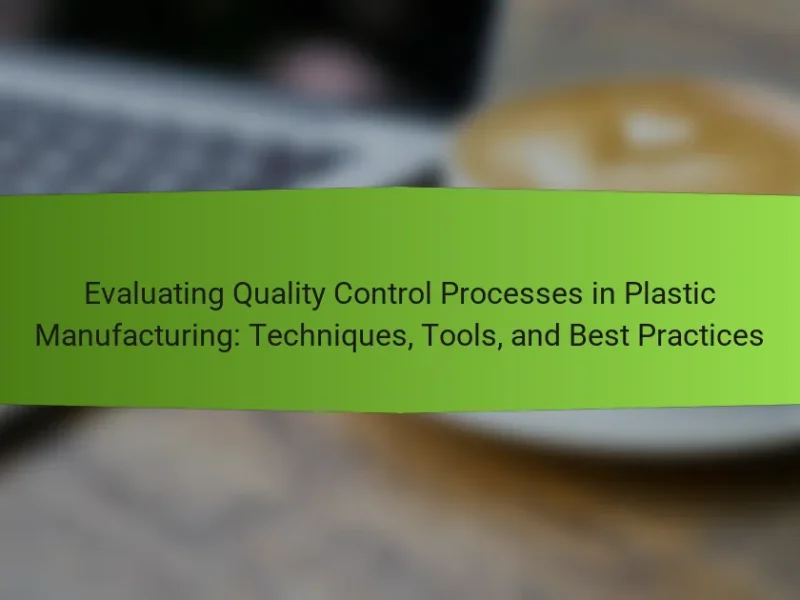FDA regulations for plastic products ensure the safety and compliance of materials used in food contact applications, as outlined in Title 21 of the Code of Federal Regulations (CFR). These regulations require manufacturers to demonstrate that their plastic products do not pose health risks through thorough testing, documentation, and adherence to specific safety standards. Compliance is essential for market approval and consumer trust, with violations potentially leading to recalls and legal consequences. The article explores the implications of these regulations on market dynamics, including production costs, innovation, and competition within the plastic products industry.
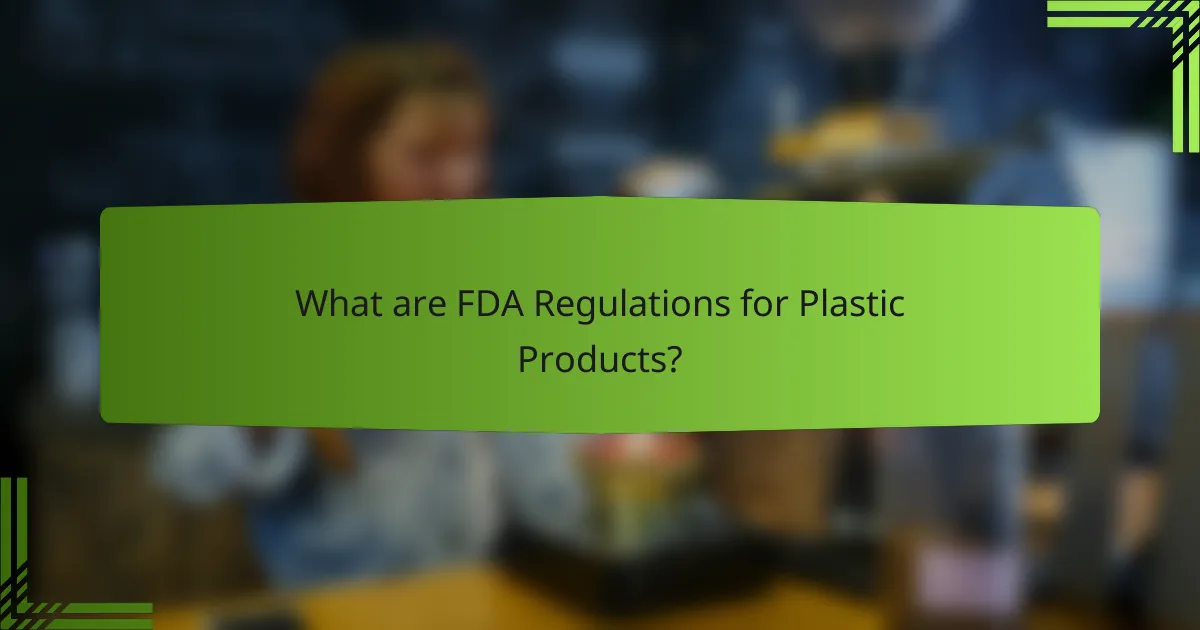
What are FDA Regulations for Plastic Products?
FDA regulations for plastic products ensure safety and compliance for materials used in food contact applications. These regulations are outlined in Title 21 of the Code of Federal Regulations (CFR). The FDA evaluates the safety of plastic substances through premarket notifications and approvals. Manufacturers must demonstrate that their plastic products do not pose health risks. Specific regulations address additives, migration limits, and overall safety assessments. Compliance with these regulations is essential for market approval. Violations can lead to product recalls and legal actions. The FDA also monitors ongoing safety and can impose additional requirements as necessary.
Why are FDA Regulations important for plastic products?
FDA regulations are important for plastic products to ensure safety and compliance. These regulations govern materials that come into contact with food and drugs. They help prevent contamination and harmful chemical leaching. For instance, plastics must meet specific standards for migration limits. The FDA conducts evaluations to assess the safety of these materials. Compliance with these regulations is crucial for market access. Non-compliance can lead to product recalls and legal penalties. Therefore, FDA regulations protect consumers and promote public health.
What specific risks do FDA Regulations aim to mitigate?
FDA Regulations aim to mitigate risks related to public health and safety. These regulations address potential hazards from food additives, contaminants, and packaging materials. They ensure that products are safe for consumption and free from harmful substances. FDA oversight helps prevent foodborne illnesses and chemical exposure. Regulations also aim to ensure accurate labeling and marketing of products. This protects consumers from misleading information. By enforcing safety standards, the FDA reduces risks associated with plastic products in the food industry.
How do FDA Regulations impact consumer safety?
FDA regulations significantly enhance consumer safety by establishing standards for food, drugs, and medical devices. These regulations require rigorous testing and evaluation of products before they reach the market. For example, the FDA mandates that manufacturers prove their products are safe and effective. This process includes reviewing clinical trial data and conducting inspections of manufacturing facilities. The regulations also enforce labeling requirements, ensuring consumers are informed about ingredients and potential risks. By doing so, the FDA helps prevent unsafe products from being sold to the public. Historical data shows that FDA oversight has reduced the incidence of foodborne illnesses and adverse drug reactions. Overall, FDA regulations play a crucial role in protecting consumer health and safety.
What types of plastic products are covered by FDA Regulations?
The FDA regulates various types of plastic products, primarily those intended for food contact. This includes plastic containers, packaging materials, and utensils. Additionally, medical devices made from plastic are also covered. The regulations ensure these products meet safety and health standards. Compliance is crucial for manufacturers to prevent contamination and protect consumer health. The FDA evaluates the materials used in these products for safety. Products must undergo testing and approval before market release. These regulations are outlined in the Federal Food, Drug, and Cosmetic Act.
Which categories of plastic products require FDA approval?
Food contact materials, medical devices, and packaging materials require FDA approval. These categories are regulated to ensure safety and effectiveness. Food contact materials include items like containers and utensils. Medical devices encompass products such as implants and diagnostic equipment. Packaging materials must meet specific safety standards to protect food and pharmaceuticals. The FDA assesses the safety of these products through rigorous testing and evaluation. Approval is necessary to prevent health risks associated with harmful substances in plastics.
How do regulations differ between consumer and industrial plastic products?
Regulations for consumer plastic products are generally stricter than those for industrial plastic products. Consumer products must meet safety standards set by organizations like the FDA and CPSC. These regulations focus on health risks, including toxicity and potential harm to users. For example, consumer plastics in food packaging must comply with specific migration limits for chemicals. In contrast, industrial plastics are often subject to fewer health-related regulations. They may focus more on performance and durability than consumer safety. Compliance for industrial products is typically guided by industry standards rather than government mandates. This distinction reflects the different risks and usage contexts associated with each category.
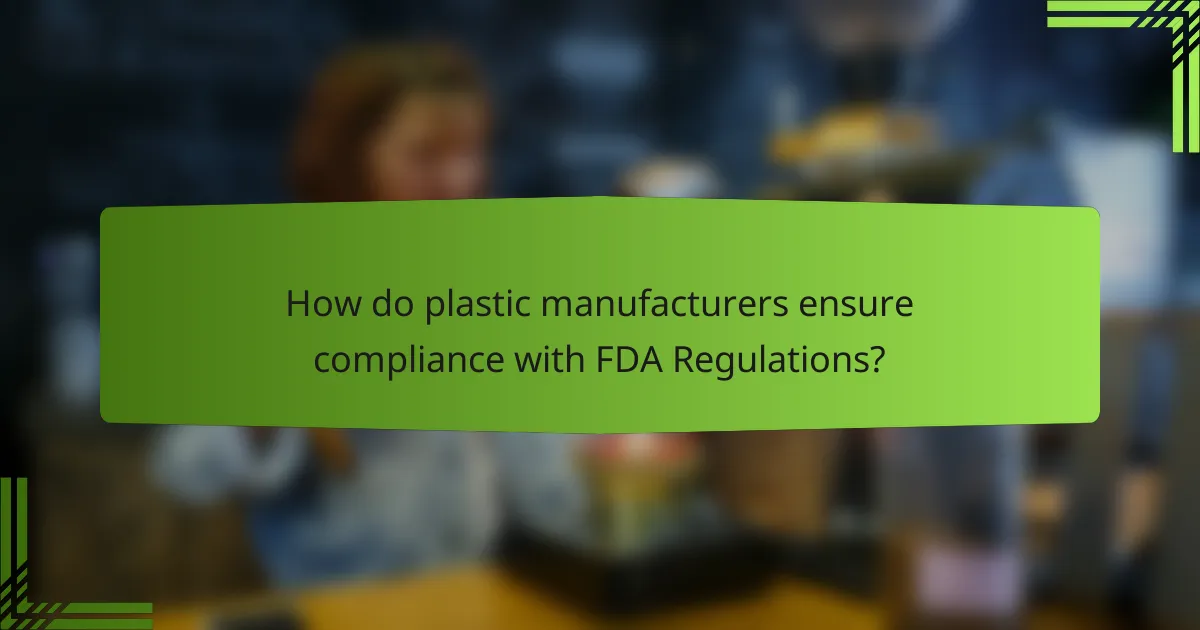
How do plastic manufacturers ensure compliance with FDA Regulations?
Plastic manufacturers ensure compliance with FDA regulations by adhering to established guidelines for materials used in food contact applications. They conduct thorough testing of plastic materials to confirm they do not leach harmful substances. Manufacturers must also maintain documentation demonstrating that their products meet FDA standards. This includes detailed specifications of the materials and processes used. Regular audits and inspections are performed to ensure ongoing compliance. Additionally, manufacturers often collaborate with regulatory consultants to navigate the complexities of FDA requirements. Compliance is further supported by staying updated on changes in regulations and guidelines issued by the FDA.
What steps do manufacturers take to comply with FDA standards?
Manufacturers comply with FDA standards by following several key steps. First, they conduct thorough research on applicable regulations. This includes understanding the specific requirements for their products. Second, they implement quality control systems to ensure product safety and efficacy. These systems often involve routine testing and validation processes. Third, manufacturers maintain detailed documentation of their compliance efforts. This documentation is crucial for audits and inspections. Fourth, they may also invest in training for employees on FDA regulations. This ensures that all staff are knowledgeable about compliance practices. Additionally, manufacturers often engage with regulatory consultants for expert guidance. This helps them navigate complex regulatory landscapes effectively. Finally, they submit necessary filings and reports to the FDA as required. This includes pre-market notifications and safety reports.
How is the compliance process monitored and enforced?
The compliance process is monitored and enforced through systematic inspections and audits by regulatory agencies. The FDA conducts regular inspections of manufacturing facilities to ensure adherence to safety standards. Non-compliance can result in warning letters, fines, or product recalls. Additionally, manufacturers are required to maintain detailed records of compliance efforts. These records are subject to review during inspections. The FDA also collaborates with state and local authorities for enforcement actions. Data from these inspections helps identify trends in compliance issues. This systematic approach ensures that plastic products meet established safety guidelines.
What documentation is required for compliance verification?
Compliance verification requires specific documentation to ensure adherence to regulations. Key documents include a Declaration of Conformity, which certifies that products meet relevant standards. Test reports from accredited laboratories are also necessary to validate compliance with safety and performance criteria. Additionally, manufacturers must maintain records of material safety data sheets (MSDS) for all substances used. Certifications from recognized bodies may be required for certain products. Keeping a detailed quality management system documentation is essential for ongoing compliance. These documents collectively demonstrate that products meet FDA regulations for safety and effectiveness.
What challenges do manufacturers face in achieving compliance?
Manufacturers face several challenges in achieving compliance with FDA regulations for plastic products. These challenges include understanding complex regulations, which often require specialized knowledge. Additionally, manufacturers must ensure that their products meet stringent safety and quality standards. This involves extensive testing and documentation, which can be time-consuming and costly.
Another significant challenge is keeping up with evolving regulations. The FDA frequently updates its guidelines, making it difficult for manufacturers to stay compliant. Furthermore, manufacturers may struggle with supply chain issues, as sourcing compliant materials can be challenging.
Lastly, the risk of penalties for non-compliance adds pressure on manufacturers. This can result in financial losses and damage to reputation. Overall, navigating the compliance landscape is a multifaceted challenge for manufacturers in the plastic products industry.
How do changes in regulations affect manufacturers’ operations?
Changes in regulations significantly impact manufacturers’ operations. They must adapt to new compliance standards. This can involve altering production processes. Manufacturers may need to invest in new technologies. Changes can also affect supply chain management. Increased regulatory scrutiny often leads to higher operational costs. Non-compliance can result in penalties or product recalls. Historical cases show that companies have faced substantial losses due to regulatory changes. For instance, the 2011 FDA Food Safety Modernization Act required many manufacturers to enhance food safety protocols.
What common pitfalls should manufacturers avoid during compliance?
Manufacturers should avoid several common pitfalls during compliance with FDA regulations. First, failing to understand the specific requirements for their products can lead to non-compliance. Each type of plastic product has unique regulations that must be adhered to. Additionally, inadequate documentation of processes and materials can result in regulatory issues. Manufacturers must maintain thorough records to demonstrate compliance.
Another pitfall is neglecting to conduct proper testing for safety and efficacy. Testing should be done according to FDA guidelines to ensure product safety. Furthermore, overlooking the importance of labeling can lead to significant problems. Labels must accurately reflect the product’s contents and intended use.
Lastly, not staying updated on regulatory changes can cause compliance failures. FDA regulations can evolve, and manufacturers must keep abreast of these changes to ensure ongoing compliance.

What are the safety standards outlined by the FDA for plastic products?
The FDA outlines several safety standards for plastic products. These standards ensure that plastic materials are safe for their intended use. The FDA requires that plastics used in food contact applications be made from substances that are approved as safe. Additionally, manufacturers must conduct safety assessments to evaluate potential health risks. The FDA also mandates labeling requirements for certain plastic products. These requirements help consumers make informed choices. Compliance with these standards is crucial for market access. Violations can result in product recalls and legal consequences.
What specific safety standards must plastic products meet?
Plastic products must meet specific safety standards set by regulatory bodies. In the United States, the Food and Drug Administration (FDA) regulates plastics intended for food contact. These plastics must comply with the FDA’s Title 21 of the Code of Federal Regulations (CFR).
The standards include safety assessments of chemical substances used in plastic production. Manufacturers must demonstrate that these substances are safe for their intended use. Additionally, plastics must not impart harmful substances to food or beverages.
Testing for migration of substances from plastic to food is also required. The FDA evaluates the safety of additives and ensures that they do not pose health risks. Compliance with these standards is crucial for market acceptance and consumer safety.
How are these safety standards tested and validated?
Safety standards are tested and validated through a series of rigorous assessments. These assessments include laboratory testing, simulations, and real-world evaluations. Independent organizations often conduct these tests to ensure objectivity. Standards set by regulatory bodies, like the FDA, provide guidelines for testing methods. Compliance with these standards is mandatory for manufacturers. Results from testing are documented and reviewed for accuracy. If a product meets the criteria, it is deemed compliant. This process helps ensure consumer safety and product reliability.
What role do third-party testing labs play in ensuring safety compliance?
Third-party testing labs play a critical role in ensuring safety compliance for products. They conduct independent evaluations of materials and products to verify adherence to safety standards. This helps manufacturers demonstrate that their products are safe for consumer use. Third-party labs utilize standardized testing methods to assess factors like chemical composition and physical properties. These evaluations often include tests for toxic substances and performance under various conditions. Regulatory bodies, including the FDA, recognize these labs for their objectivity and expertise. Their certifications can significantly influence market access and consumer trust. In 2021, the FDA reported that third-party testing helped identify non-compliant products, enhancing overall safety in the market.
How do safety standards impact product design and development?
Safety standards significantly influence product design and development by establishing essential guidelines for manufacturers. These standards ensure that products meet specific safety requirements before reaching consumers. Compliance with safety standards often dictates materials, processes, and testing methods used in design. For example, the FDA regulations require that plastic products intended for food contact must be safe and non-toxic. This leads designers to select appropriate materials that comply with these regulations. Additionally, safety standards can impact the product lifecycle, requiring ongoing testing and validation. Manufacturers may face legal repercussions if products do not meet safety standards, motivating adherence to these guidelines. Overall, safety standards shape the entire development process, from concept to market launch.
What considerations must manufacturers take into account during product design?
Manufacturers must consider regulatory compliance during product design. This includes adhering to FDA regulations for safety and material standards. Manufacturers should evaluate the intended use of the product. They must also assess the potential risks associated with the materials used. Environmental impact is another critical factor. Manufacturers should consider the recyclability and sustainability of their products. User safety and ergonomics must be prioritized in design. Additionally, manufacturers should plan for cost-effectiveness and manufacturability. These considerations ensure that products meet market demands and regulatory requirements.
How do safety standards influence material selection for plastic products?
Safety standards significantly influence material selection for plastic products. These standards ensure that materials are safe for their intended use, particularly in food packaging and medical applications. Compliance with safety regulations, such as those set by the FDA, dictates the types of plastics that can be used. For example, materials must be non-toxic and resistant to leaching harmful substances. Manufacturers often choose FDA-approved plastics, like polyethylene and polypropylene, to meet these criteria. Additionally, safety standards require testing for durability and performance under various conditions. This ensures that the selected materials can withstand environmental factors without compromising safety. Overall, adherence to safety standards shapes the decision-making process in material selection for plastic products.
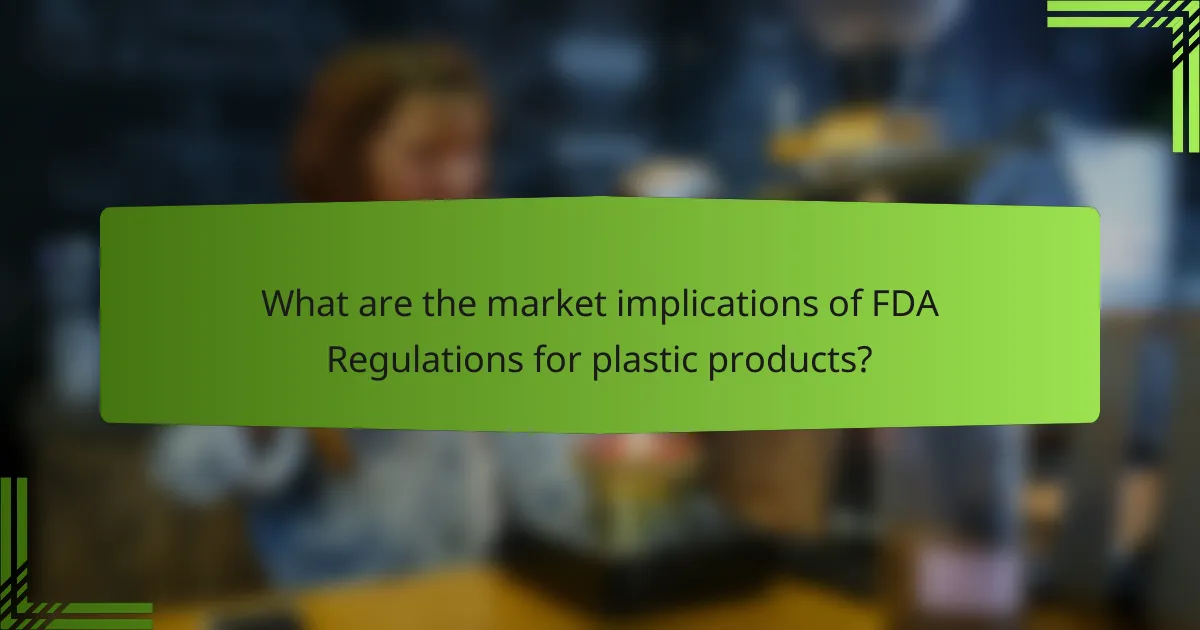
What are the market implications of FDA Regulations for plastic products?
FDA regulations for plastic products significantly impact market dynamics. Compliance with these regulations ensures product safety and consumer trust. Companies must invest in testing and certification processes. This can increase production costs and affect pricing strategies. Non-compliance may lead to product recalls and legal penalties. Such risks can deter investment in plastic product development. Additionally, regulations can drive innovation towards safer materials. Market competition may shift as companies adapt to regulatory changes. Overall, FDA regulations shape the landscape of the plastic products market.
How do FDA Regulations affect market access for plastic products?
FDA regulations significantly impact market access for plastic products. These regulations ensure that plastic materials used in food contact applications are safe. Compliance with FDA standards is mandatory for manufacturers. Non-compliance can lead to product recalls or bans. The FDA evaluates materials based on safety data and intended use. Approval processes can be lengthy and complex. Products must undergo rigorous testing to demonstrate safety. Meeting these requirements is essential for market entry.
What impact do regulations have on product pricing and competitiveness?
Regulations significantly impact product pricing and competitiveness. Compliance with regulations often increases production costs for manufacturers. These costs can arise from required safety testing, certification processes, and adherence to quality standards. As a result, companies may raise prices to maintain profit margins. Higher prices can limit competitiveness, especially against unregulated or less regulated markets. For instance, the FDA’s stringent requirements for plastic products can lead to higher costs compared to competitors in countries with looser regulations. This disparity can affect market share and consumer choice, ultimately shaping industry dynamics.
How do consumer perceptions of safety influence market demand?
Consumer perceptions of safety significantly influence market demand. When consumers believe a product is safe, they are more likely to purchase it. This is especially true for products regulated by the FDA, such as plastic items. A study by the Food Marketing Institute found that 65% of consumers prioritize safety when making purchasing decisions. Conversely, if consumers perceive a product as unsafe, demand decreases. Negative safety perceptions can stem from recalls or safety violations. For instance, a recall of a plastic product can lead to a 20% drop in sales. Thus, consumer perceptions directly correlate with market demand for products.
What are the future trends in FDA Regulations for plastic products?
Future trends in FDA regulations for plastic products include increased scrutiny on safety and environmental impact. The FDA is likely to enhance testing requirements for chemical leaching from plastics. This trend aligns with growing public concern over plastic pollution. Regulations may also focus on biodegradable and compostable plastics. The FDA might implement stricter labeling requirements to inform consumers about plastic content. Additionally, there’s a potential push for transparency in sourcing and manufacturing practices. Industry stakeholders may face more comprehensive compliance measures. These trends reflect a broader commitment to health and sustainability in consumer products.
How might emerging technologies impact regulatory practices?
Emerging technologies may significantly alter regulatory practices by enhancing monitoring and compliance capabilities. Technologies like artificial intelligence can analyze vast data sets for real-time compliance assessments. Blockchain can provide transparent supply chain tracking, ensuring product authenticity and safety. Drones and IoT devices can facilitate remote inspections and data collection in manufacturing environments. These innovations enable faster responses to safety issues and more efficient regulatory processes. For instance, the FDA has begun utilizing digital tools to streamline its oversight of food and drug safety. This shift can lead to more adaptive and responsive regulatory frameworks that keep pace with technological advancements.
What changes can manufacturers anticipate in upcoming regulations?
Manufacturers can anticipate stricter compliance requirements in upcoming FDA regulations for plastic products. These changes may include enhanced safety standards for materials used in food contact applications. Manufacturers will likely need to provide more detailed documentation of material safety and sourcing. The FDA may also increase scrutiny on the environmental impact of plastic products. Additionally, there could be new labeling requirements for transparency regarding chemical content. These anticipated changes aim to promote consumer safety and environmental sustainability. Historical trends indicate that regulatory bodies are increasingly focused on public health and ecological concerns.
What best practices should manufacturers follow for FDA compliance?
Manufacturers should follow several best practices for FDA compliance. First, they must understand applicable regulations. This includes the Federal Food, Drug, and Cosmetic Act. Next, manufacturers should maintain thorough documentation. Records should include design, production, and quality control processes. Regular training for staff on compliance is essential. It ensures that everyone understands their roles and responsibilities. Additionally, conducting routine audits helps identify potential non-compliance issues. Manufacturers should also engage in risk assessment practices. This identifies hazards associated with their products. Finally, establishing a clear communication channel with the FDA is crucial. This allows for prompt reporting of any adverse events or product issues. Following these practices helps ensure compliance and enhances product safety.
The main entity of this article is FDA regulations for plastic products, which are crucial for ensuring safety and compliance in materials used for food contact applications. The article provides a comprehensive overview of the regulatory framework outlined in Title 21 of the Code of Federal Regulations, detailing the requirements for manufacturers to demonstrate product safety, including testing for harmful substances and adherence to migration limits. It discusses the importance of these regulations in mitigating public health risks, the impact on consumer safety, and the specific types of plastic products that require FDA approval. Additionally, the article explores the challenges manufacturers face in achieving compliance, the implications of regulations on market access and pricing, and future trends in regulatory practices.
